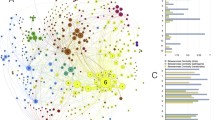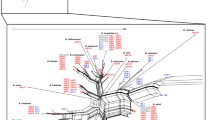Abstract
Ticks are often infected with more than one pathogen, and several field surveys have documented nonrandom levels of coinfection. Levels of coinfection by pathogens in four tick species were analyzed using published infection data. Coinfection patterns of pathogens in field-collected ticks include numerous cases of higher or lower levels of coinfection than would be expected due to chance alone, but the vast majority of these cases can be explained on the basis of vertebrate host associations of the pathogens, without invoking interactions between pathogens within ticks. Nevertheless, some studies have demonstrated antagonistic interactions, and some have suggested potential mutualisms, between pathogens in ticks. Negative or positive interactions between pathogens within ticks can affect pathogen prevalence, and thus transmission patterns. Probabilistic projections suggest that the effect on transmission depends on initial conditions. When the number of tick bites is relatively low (e.g., for ticks biting humans) changes in prevalence in ticks are predicted to have a commensurate effects on pathogen transmission. In contrast, when the number of tick bites is high (e.g., for wild animal hosts) changes in pathogen prevalence in ticks have relatively little effect on levels of transmission to reservoir hosts, and thus on natural transmission cycles.

Similar content being viewed by others
References
Alekseev AN, Burenkova LA, Vasil’eva IS, Dubinina EV, Chunikhin SP (1996) The functioning of foci of mixed tick-borne infections on Russian territory. Med Parazitol (Mosk) 4:9–16 in Russian
Alekseev AN, Semenov AV, Dubinina HV (2003) Evidence of Babesia microti infection in multi-infected Ixodes persulcatus ticks in Russia. Exp Appl Acarol 29:345–353
Belongia EA (2002) Epidemiology and impact of coinfections acquired from Ixodes ticks. Vector-Borne Zoon Dis 2:265–273
Burgdorfer W, Hates SF, Mavros AJ (1981) Nonpathogenic rickettsiae in Dermacentor andersoni: a limiting factor for the distribution of Rickettsia rickettsii. In: Burgdorfer W, Anacker RI (eds) Rickettsiae and rickettsial diseases. Academic Press, New York, NY, pp 585–594
Christova I, Schouls L, van de Pol I, Park J, Panayotov S, Lefterova V, Kantardjiev T, Dumler JS (2001) High prevalence of granulocytic ehrlichiae and Borrelia burgdorferi sensu lato in Ixodes ricinus ticks from Bulgaria. J Clin Microbiol 39:4172–4174
Dawson JE, Ewing SA, Davidson WR, Childs JE, Little SE, Standaert SM (2005) Human monocytotropic ehrlichiosis. In: Goodman JL, Dennis DT, Sonenshine DE (eds) Tick-borne diseases of humans. ASM Press, Washington, DC, USA, pp 292–301
De la Fuente J, Garcia-Garcia JC, Blouin EF, Saliki JT, Kocan KM (2002) Infection of tick cells and bovine erythrocytes with one genotype of the intracellular ehrlichia Anaplasma marginale excludes infection with other genotypes. Clin Diagnostic Lab Immunol 9:658–668
De la Fuente J, Blouin EF, Kocan KM (2003) Infection exclusion of the rickettsial pathogen Anaplasma marginale in the tick vector Dermacentor variabilis. Clin Diagnostic Lab Immunol 10:182–184
Ginsberg HS (1993) Transmission risk of Lyme disease and implications for tick management. Am J Epidemiol 138:65–73
Ginsberg HS (2001) Integrated pest management and allocation of control efforts for vector-borne diseases. J Vector Ecol 26:32–38
Ginsberg HS, Buckley PA, Balmforth MG, Zhioua E, Mitra S, Buckley FG (2005) Reservoir competence of native North American birds for the Lyme disease spirochete, Borrelia burgdorferi. J Med Entomol 42:445–449
Golubić D, Rijpkema S, Tkalec-Makovec N, Ruzić E (1998) Epidemiologic, ecologic and clinical characteristics of Lyme borrelliosis in northwest Croatia. Acata Med Croatica 52:7–13
Hanincová K, Schäfer SM, Etti S, Sewell H-S, Taragelová V, Ziak D, Labuda M, Kurtenbach K (2003a) Association of Borrelia afzelii with rodents in Europe. Parasitol 126:11–20
Hanincová K, Taragelová V, Koci J, Schäfer SM, Hails R, Ullmann AJ, Piesman J, Labuda M, Kurtenbach K (2003b) Association of Borrelia garinii and B valaisiana with songbirds in Slovakia. Appl Envir Microbiol 69:2825–2830
Hildebrandt A, Schmidt KH, Wilske B, Dorn W, Straube E, Fingerle V (2003) Prevalence of four species of Borrelia burgdorferi sensu lato and coinfection with Anaplasma phagocytophila in Ixodes ricinus ticks in central Germany. Eur J Clin Microbiol Infect Dis 22:364–367
Hornbostel VL, Ostfeld RS, Zhioua E, Benjamin MA (2004) Sublethal effects of Metarhizium anisopliae (Deuteromycetes) on engorged larval, nymphal, and adult Ixodes scapularis (Acari: Ixodidae). J Med Entomol 41:922–929
Hornbostel VL, Ostfeld RS, Benjamin MA (2005) Effectiveness of Metarhizium anisopliae (Deuteromycetes) against Ixodes scapularis (Acari: Ixodidae) engorging on Peromyscus leucopus. J Vector Ecol 30:91–101
Hu CM, Humair P-F, Wallich R, Gern L (1997) Apodemus sp. rodents, reservoir hosts for Borrelia afzelii in an endemic area in Switzerland. Zentralbl Bakteriol 285:558–564
Kirstein F, Rijpkema S, Molkenboer M, Gray JS (1997) Local variation in the distribution and prevalence of B burgdorferi sensu lato genomospecies in Ixodes ricinus ticks. Appl Environ Microbiol 63:1102–1106
Korenberg EI, Kovalevskii YV, Karavanov AS, Moskvitina GG (1999) Mixed infection by tick-borne encephalitis virus and Borrelia in ticks. Med Vet Entomol 13:204–208
Kurtenbach K, Schäfer SM, de Michelis S, Etti S, Sewell H-S (2002) Borrelia burgdorferi sensu lato in the vertebrate host. In: Gray JS, Kahl O, Lane RS, Stanek G (eds) Lyme borreliosis, biology epidemiology and control. CABI Publishing, Oxon, UK, pp 117–148
Levin ML, Fish D (2000) Acquisition of coinfection and simultaneous transmission of Borrelia burgdorferi and Ehrlichia phagocytophila by Ixodes scapularis ticks. Infect Immun 68:2183–2186
Levine JF, Wilson ML, Spielman A (1985) Mice as reservoirs of the Lyme disease spirochete. Am J Trop Med Hyg 34:355–360
Macaluso KR, Azad AF (2005) Rocky Mountain Spotted Fever and other spotted fever group rickettsioses. In: Goodman JL, Dennis DT, Sonenshine DE (eds) Tick-borne diseases of humans. ASM Press, Washington, DC, USA, pp 292–301
Macaluso KR, Sonenshine DE, Ceraul SM, Azad AF (2002) Rickettsial infection in Dermacentor variabilis (Acari: Ixodidae) inhibits transovarial transmission of a second Rickettsia. J Med Entomol 39:809–813
Mather TN, Piesman J, Spielman A (1987) Absence of spirochetes (Borrelia burgdorferi) and piroplasms (Babesia microti) in deer ticks (Ixodes dammini) parasitized by chalcid wasps (Hunterellus hookeri). Med Vet Entomol 1:3–8
Mixson TR, Campbell SR, Gill JS, Ginsberg HS, Reichard MV, Schulze TL, Dasch GA (2006) Prevalence of Ehrlichia, Borrelia, and Rickettsial agents in Amblyomma americanum collected from nine states. J Med Entomol 43:1261–1268
Morozova OV, Dobrotvorsky AK, Livanova NN, Tkachev SE, Bakhvalova VN, Beklemishev AB, Cabello FC (2002) PCR detection of Borrelia burgdorferi sensu lato, tick-borne encephalitis virus, and the human granulocytic ehrlichiosis agent in Ixodes persulcatus ticks from western Siberia, Russia. J Clin Microbiol 40:3802–3804
Nefedova VV, Korenberg EI, Gorelova NB, Kovalevskii YV (2004) Studies on the vertical transmission of Borrelia burgdorferi sensu lato in the taiga tick Ixodes persulcatus. Folia Parasitol 51:67–71
Paddock CD, Liddell AM, Storch GA (2005) Other causes of tick-borne ehrlichioses, including Ehrlichia ewingi. In: Goodman JL, Dennis DT, Sonenshine DE (eds) Tick-borne diseases of humans. ASM Press, Washington, DC, USA, pp 258–267
Postic D, Korenberg E, Gorelova N, Kovalevski YV, Belenger E, Baranton G (1997) Borrelia burgdorferi sensu lato in Russia and neighboring countries: high incidence of mixed isolates. Res Microbiol 148:691–702
Rauter C, Rainer O, Diterich I, Engele M, Hartung T (2002) Distribution of clinically relevant Borrelia genospecies in ticks assessed by a novel, single-run, real-time PCR. J Clin Microbiol 40:36–43
Richter D, Spielman A, Komar N, Matuschka FR (2000) Competence of American robins as reservoir hosts for Lyme disease spirochetes. Emerg Infect Dis 6:133–138
Ross DE, Levin ML (2004) Effects of Anaplasma phagocytophilum infection on the molting success of Ixodes scapularis (Acari: Ixodidae) larvae. J Med Entomol 41:476–483
Rudakov NV, Shpynov SN, Samoilenko IE, Tankibaev MA (2003) Ecology and epidemiology of Spotted Fever Group rickettsiae and new data from their study in Russia and Kazakhstan. Ann NY Acad Sci 990:12–24
Samish M, Ginsberg H, Glazer I (2004) Biological control of ticks. Parasitology 129:S389–S403
Schriefer ME, Azad AF (1994) Changing ecology of Rocky Mountain Spotted Fever. In: Sonenshine DE, Mather TN (eds) Ecological dynamics of tick-borne zoonoses. Oxford University Press, New York, pp 314–326
Schulze TL, Jordan RA, Schulze CJ, Mixson T, Papero M (2005) Relative encounter frequencies and prevalence of selected Borrelia, Ehrlichia, and Anaplasma infections in Amblyomma americanum and Ixodes scapularis (Acari: Ixodidae) ticks from central New Jersey. J Med Entomol 42:450–456
Stańczak J, Racewicz M, Kruminis-Lozowska W, Kubica-Biernat B (2002) Coinfection of Ixodes ricinus (Acari: Ixodidae) in northern Poland with the agents of Lyme borreliosis (LB) and human granulocytic ehrlichiosis (HGE). Int J Med Microbiol 291(Suppl 33):198–201
Stańczak J, Gabre RM, Kruminis-Lozowska W, Racewicz M, Kubica-Biernat B (2004) Ixodes ricinus as a vector of Borrelia burgdorferi sensu lato, Anaplasma phagocytophilum and Babesia microti in urban and suburban forests. Ann Agric Environ Med 11:109–114
Steiner FE, Pinger RR, Vann CN, Abley MJ, Sullivan B, Grindle N, Clay K, Fuqua C (2006) Detection of Anaplasma phagocytophilum and Babesia odocoilei DNA in Ixodes scapularis (Acari: Ixodidae) collected in Indiana. J Med Entomol 43:437–442
Sutáková G, Rehácek J (1990) Mixed infection of Rickettsiella phytoseiuli and Coxiella burnetii in Dermacentor reticulatus female ticks: electron microscope study. J Invert Pathol 55:407–416
Swanson KI, Norris DE (2007) Co-circulating microorganisms in questing Ixodes scapularis nymphs in Maryland. J Vector Ecol 32:243–251
Telford SRIII, Dawson JE, Katavolos P, Warner CK, Kolbert CP, Persing DH (1996) Perpetuation of the agent of human granulocytic ehrlichiosis in a deer tick-rodent cycle. Proc Natl Acad Sci USA 93:6209–6214
Thomas V, Anguita J, Barthold SW, Fikrig E (2001) Coinfection with Borrelia burgdorferi and the agent of human granulocytic ehrlichiosis alters murine immune responses, pathogen burden, and severity of Lyme arthritis. Infect Immun 69:3359–3371
Acknowledgements
I thank R.A. LeBrun and G. Olsen for constructive comments on early drafts of the manuscript. This work was supported by the U.S. Geological Survey, Patuxent Wildlife Research Center.
Author information
Authors and Affiliations
Corresponding author
Rights and permissions
About this article
Cite this article
Ginsberg, H.S. Potential effects of mixed infections in ticks on transmission dynamics of pathogens: comparative analysis of published records. Exp Appl Acarol 46, 29–41 (2008). https://doi.org/10.1007/s10493-008-9175-5
Received:
Accepted:
Published:
Issue Date:
DOI: https://doi.org/10.1007/s10493-008-9175-5




